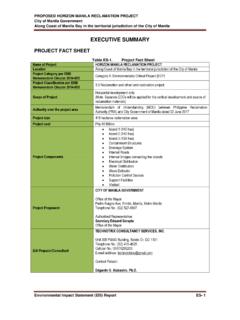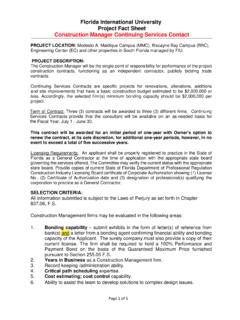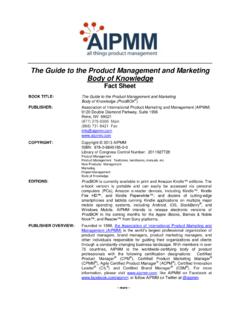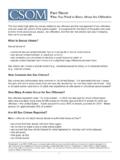Transcription of Project Management Fact Sheet - University of Houston ...
1 Inter Agency Policy and Projects Unit Department of Premier and Cabinet Project Management fact Sheet : Closing a Project Version: , November 2008 DISCLAIMER This material has been prepared for use by Tasmanian Government agencies and Instrumentalities. It follows that this material should not be relied upon by any other person. Furthermore, to the extent that this material is relied upon , the Crown in Right of the State of Tasmania gives no warranty as to the accuracy or correctness of the material or for any advice given or for omissions from the material. Users rely on the material at their own risk.
2 Page 2 Tasmanian Government Project Management Framework Project Management fact Sheet : Closing a Project , Version: , November 2008 The Tasmanian Government Project Management Guidelines state that successful Project finalisation involves the formal acceptance of Project outputs by the Business Owners, an internal review of Project outputs and outcomes against the Project Business Plan, disbanding of the Project Team and tying up of loose ends. This fact Sheet explains the process for closing a Project , using the following scenarios: Scenario 1 A Project that has delivered all of its outputs, had them accepted by the Business Owner(s) and realised its target outcomes prior to the Project Team disbanding.
3 Scenario 2 - A Project for which the target outcomes have been secured but will not be realised until 6 months after the handover and acceptance of the outputs by the Business Owner(s) and the Project Team has disbanded. Scenario 3 - A Project for which the target outcomes will not be fully realised until 5 years after the handover and acceptance of the outputs by the Business Owner(s) with the Project Team having probably completed a number of other projects by then. Where guidelines detailing the requirements for information Management exist within an Agency, they should be read in conjunction with this fact Sheet .
4 What is Project Closure? Project Closure is the formal ending or termination of a Project . With a successfully completed Project , this will occur once all of the work of the Project is finished, all of the outputs have been delivered and accepted by the Business Owner(s) and the target outcomes have been or are being realised. Why is it important to Formally close a Project ? As defined in the Tasmanian Government Project Management Guidelines, a Project involves a group of inter-related activities that are planned and then executed in a certain sequence to create a unique product or service, within a specific time frame in order to achieve planned outcomes.
5 This means that all projects have an end date by which time all of the inter-related activities are complete. Projects that are not formally closed often drift on . Usually this is a sign that there has been a loss of control of the Project and symptoms such as continually changing scope, a continued demand for resources and an indeterminate final delivery date are displayed. This results in, amongst other things, lack of ownership by the Business Owners, a failure to embed the outputs into the normal business operations of the organisation, continued use of resources, changed and/or enhanced outputs.
6 In addition, Project documentation is often not finalised and filed according to relevant Records and Information Management Guidelines. This may be avoided by adopting a Project Management approach and, for larger projects, the establishment of an effective Steering Committee. Who is responsible for Project closure? The Steering Committee, or Project Sponsor in the case of a smaller Project , is responsible for formally closing a Project . The decision as to the timing may be proposed by the Project Sponsor, in consultation with the Project Manager. When can a Project be closed? A Project should be closed when all the work of the Project is finished, all of the outputs have been delivered and accepted (or arrangements are in place for this to occur) by the Business Owner(s) and the target outcomes have been or are being generated.
7 Page 3 Tasmanian Government Project Management Framework Project Management fact Sheet : Closing a Project , Version: , November 2008 The Project Business Plan will provide the basis for the Steering Committee to determine when this has occurred. But there can be a problem when the delivery of outputs, acceptance by the Business Owner(s) and realisation of the outcomes are spread over a period of time, several years. The Project Team usually disbands once the outputs have been delivered and accepted, and there is often no Project budget once the team has disbanded.
8 In this case, a decision will need to be made as to who and how the residual tasks are performed arranging and managing the post Project review. One approach to solving this problem is to look at a Project having two closure points: Closure Stage 1 - when the Project Team disbands after the Project outputs have been delivered to and accepted by the Business Owner(s) Closure Stage 2 - when the targeted Project outcomes have been realised Closure Stage 1: The Steering Committee will need to be satisfied that the following have been satisfactorily addressed: A final Project Manager s Status Report or Project Review and Closure Report has been endorsed by the Steering Committee All of the outputs have been produced, as per the Project Business Plan (this may form part of the Project Review and Closure Report) Project outputs have been handed over and accepted by the Business Owner(s)
9 This requires a written statement of acceptance to the Steering Committee or Project Sponsor, or may form part of a formal handover and acceptance process adopted by the Project An Outcome Realisation Plan has been approved by the Project Sponsor and Business Owners Achievement of the Project target outcomes has been assessed at this point in the Project life cycle (this may form part of the Project Review and Closure Report or Post Project Review Report) The lessons learnt have been captured from the Project Team members, the Project Manager and any other key stakeholders (this may form part of the Project Review and Closure Report or Post Project Review Report) In the case of larger projects, a post Project review, as detailed in the Project Business Plan, has been completed and accepted.
10 The Project Business Plan should detail the type of review, when it should take place, who is responsible for arranging and managing the review, who will undertake the review and who is responsible for accepting the Post Project Review Report The Project Team has been disbanded Physical resources and assets have been disposed of or re-assigned appropriately such as office equipment, computers and software licences Financial resources have been fully accounted for, all costs have been paid and any surplus distributed appropriately Documentation, including electronic and hard copies have been filed in accordance with the Records Management Plan outlined in the Project Business Plan and Agency Records Management Guidelines It is at this stage in the Project that the Project completion celebrations usually take place.









